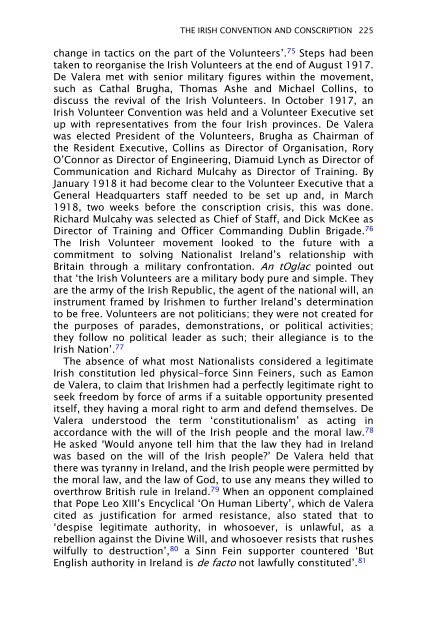Dividing Ireland: World War I and Partition
Dividing Ireland: World War I and Partition
Dividing Ireland: World War I and Partition
You also want an ePaper? Increase the reach of your titles
YUMPU automatically turns print PDFs into web optimized ePapers that Google loves.
THE IRISH CONVENTION AND CONSCRIPTION 225<br />
change in tactics on the part of the Volunteers’. 75 Steps had been<br />
taken to reorganise the Irish Volunteers at the end of August 1917.<br />
De Valera met with senior military figures within the movement,<br />
such as Cathal Brugha, Thomas Ashe <strong>and</strong> Michael Collins, to<br />
discuss the revival of the Irish Volunteers. In October 1917, an<br />
Irish Volunteer Convention was held <strong>and</strong> a Volunteer Executive set<br />
up with representatives from the four Irish provinces. De Valera<br />
was elected President of the Volunteers, Brugha as Chairman of<br />
the Resident Executive, Collins as Director of Organisation, Rory<br />
O’Connor as Director of Engineering, Diamuid Lynch as Director of<br />
Communication <strong>and</strong> Richard Mulcahy as Director of Training. By<br />
January 1918 it had become clear to the Volunteer Executive that a<br />
General Headquarters staff needed to be set up <strong>and</strong>, in March<br />
1918, two weeks before the conscription crisis, this was done.<br />
Richard Mulcahy was selected as Chief of Staff, <strong>and</strong> Dick McKee as<br />
Director of Training <strong>and</strong> Officer Comm<strong>and</strong>ing Dublin Brigade. 76<br />
The Irish Volunteer movement looked to the future with a<br />
commitment to solving Nationalist <strong>Irel<strong>and</strong></strong>’s relationship with<br />
Britain through a military confrontation. An tOglac pointed out<br />
that ‘the Irish Volunteers are a military body pure <strong>and</strong> simple. They<br />
are the army of the Irish Republic, the agent of the national will, an<br />
instrument framed by Irishmen to further <strong>Irel<strong>and</strong></strong>’s determination<br />
to be free. Volunteers are not politicians; they were not created for<br />
the purposes of parades, demonstrations, or political activities;<br />
they follow no political leader as such; their allegiance is to the<br />
Irish Nation’. 77<br />
The absence of what most Nationalists considered a legitimate<br />
Irish constitution led physical-force Sinn Feiners, such as Eamon<br />
de Valera, to claim that Irishmen had a perfectly legitimate right to<br />
seek freedom by force of arms if a suitable opportunity presented<br />
itself, they having a moral right to arm <strong>and</strong> defend themselves. De<br />
Valera understood the term ‘constitutionalism’ as acting in<br />
accordance with the will of the Irish people <strong>and</strong> the moral law. 78<br />
He asked ‘Would anyone tell him that the law they had in <strong>Irel<strong>and</strong></strong><br />
was based on the will of the Irish people?’ De Valera held that<br />
there was tyranny in <strong>Irel<strong>and</strong></strong>, <strong>and</strong> the Irish people were permitted by<br />
the moral law, <strong>and</strong> the law of God, to use any means they willed to<br />
overthrow British rule in <strong>Irel<strong>and</strong></strong>. 79 When an opponent complained<br />
that Pope Leo XIII’s Encyclical ‘On Human Liberty’, which de Valera<br />
cited as justification for armed resistance, also stated that to<br />
‘despise legitimate authority, in whosoever, is unlawful, as a<br />
rebellion against the Divine Will, <strong>and</strong> whosoever resists that rushes<br />
wilfully to destruction’, 80 a Sinn Fein supporter countered ‘But<br />
English authority in <strong>Irel<strong>and</strong></strong> is de facto not lawfully constituted’. 81








